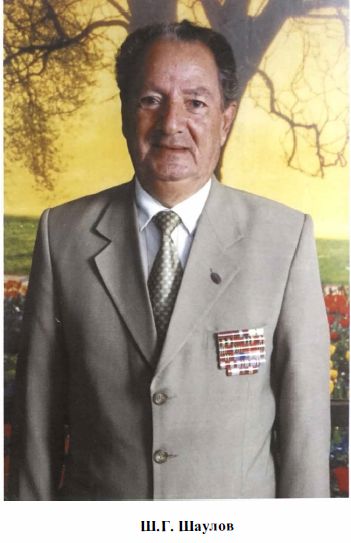Shaul Shaulov was born in 1918 in Gyrmyzy Gasaba (also known under its Russian name, Krasnaia Sloboda) in northeastern Azerbaijan, near the town of Quba (Guba), in a family of Mountain Jews. His father Gavriel was a petty tradesman. In 1937, Shaul entered the Azerbaijan Medical Institute (University) in Baku, from which he graduated in 1942, when the Soviet-German War was already in full swing.
In September 1942, the graduates of the Azerbaijan Medical Institute were transferred to Soviet Central Asia, where they were assigned to various military units. Shaulov was sent to the Urals for military training. In December that year, Lieutenant Shaulov was dispatched as a physician and the commander of a sanitary platoon to the area of Velikie Luki, on the Northwestern Front. It was very hard for him, as a native of the Caucasus, to adjust to the temperatures of -25 degrees Celsius (-13 degrees Fahrenheit) that were typical of that region. Shaulov’s duty was not only to give medical aid to the wounded, but sometimes also to search the battlefield for wounded and shell-shocked combatants, together with the other field medics. In some cases, he had to take up weapons and fight alongside the soldiers.
That sector of the Soviet-German frontline moved very little after January 1943 (with the major military operations going on in the south), but some battles did take place there from time to time, with heavy casualties. In December 1943, Shaulov was attached to a separate ski battalion that had to reach the shore of Lake Ilmen, which lay in the German rear at the time, to carry out a “special assignment”. The operation was not very successful: The Germans discovered the battalion and shelled it heavily. After collecting the wounded, Shaulov and his assistants realized that they were surrounded by the enemy. Lieutenant Shaulov managed to cross the frontline in the night and bring 15 wounded men (two of them, whose injuries were particularly severe, died on the way) over to the Soviet side. For this accomplishment, Senior Lieutenant Shaulov was awarded the Order of the Red Star in 1944, when his 282nd Rifle Division was already fighting in Latvia.
In late 1944, Shaulov’s division was transferred to Poland. He saw action in southern Poland and ended the war in Germany and Czechoslovakia. After V-E Day, he continued his military service in Hungary, and was then transferred to Tallinn, Estonia, where he was finally discharged from the army in July 1946. Shaulov returned to Gyrmyzy Gasaba, Azerbaijan, where he married. In 1946-54, he worked as a surgeon in the nearby town of Guba; from 1954 on, he worked as a pediatrician.
In 1996, Shaul Shaulov and his family immigrated to Israel and settled in Tirat Carmel. Shaulov was an active member of the local Committee of War Veterans. He died in 2004.
Additional Information
Children buried alive
“In December 1943, the unit in which I served, pursuing the enemy, entered the village of Gorodishchi, which lay near Staraia Russa [It is unclear which of the villages named Gorodishchi, or Gorodishche, is referred to here; most probably, the one on Lake Ilmen, southeast of Novgorod].In December 1943, the unit in which I served, pursuing the enemy, entered the village of Gorodishchi, which was near Starye Russy.
In December 1943, a part in which I served, in pursuit of the enemy, entered the village settlement, is near Staraya Russa.
The Germans had retreated from there on the previous night. The Germans left there the night before.
Before retreating, they had set fire to the houses, and their shells continued to smolder and smoke. Before retreating, they set fire to houses, and their ruins continued to smolder and smoke.
The local residents, who were hiding in a nearby forest, began to emerge.…
The inhabitants who were hiding there began to emerge from the nearby forest.
From the recent forest began to leave the inhabitants hiding there.
They took us to the outskirts of the village. They took us to the outskirts of the village.
There, in the middle of a snow-covered field, we saw black, freshly dug earth. The locals said that this was a carelessly covered grave. On the night before leaving the village, the Germans brought several Jewish families – men, women, and children – whom they had arrested in nearby villages to this place. The Germans brought several Jewish families - men, women and children - captured in neighboring villages to this place the night before leaving the village.
The Germans last night before leaving the village led to this place several families of Jews - men, women and children trapped in the neighboring villages.
The men were forced to dig a grave, and afterward all the adults were shot, while the children were thrown alive into the pit, which was then hastily covered with soil. The men were forced to dig a grave, after which all the adults were shot, and the children were thrown alive into a pit, which was then hastily covered with earth.
The children buried alive in this grave died.Children buried alive in this grave died.
We immediately exhumed this terrible pit, to made sure that everything they had told us was true. There were no gunshot wounds on the bodies of the dead children; they had indeed been buried alive. The villagers standing next to us were crying. We cried, too. The soldiers and officers could not hold back their tears, even after all the other terrible things they had witnessed since the beginning of the war. A brief meeting was then convened at that place, and we swore an oath to strike at the enemy without mercy, to make them pay for all the atrocities they had committed.
I shall never forget the terrible scene I beheld on the outskirts of the village of Gorodishchi”.[Sh.G. Shaulov, Osoboie poruchenie
[A Special Assignment], Israel [sic!], 2001, pp. 15-16]







